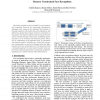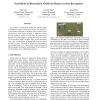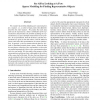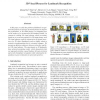CVPR
2012
IEEE
12 years 3 months ago
2012
IEEE
Real-time recognition may be limited by scarce memory and computing resources for performing classification. Although, prior research has addressed the problem of training classif...
CVPR
2012
IEEE
12 years 3 months ago
2012
IEEE
Our goal is to segment a video sequence into moving objects and the world scene. In recent work, spectral embedding of point trajectories based on 2D motion cues accumulated from ...
CVPR
2012
IEEE
12 years 3 months ago
2012
IEEE
We present a hierarchical model for human activity recognition in entire multi-person scenes. Our model describes human behaviour at multiple levels of detail, ranging from low-le...
CVPR
2012
IEEE
12 years 3 months ago
2012
IEEE
We consider the problem of finding a few representatives for a dataset, i.e., a subset of data points that efficiently describes the entire dataset. We assume that each data poi...
CVPR
2012
IEEE
12 years 3 months ago
2012
IEEE
Recently sparse representation has been applied to visual tracker by modeling the target appearance using a sparse approximation over a template set, which leads to the so-called ...
CVPR
2012
IEEE
12 years 3 months ago
2012
IEEE
In this paper, we study the problem of landmark recognition and propose to leverage 3D visual phrases to improve the performance. A 3D visual phrase is a triangular facet on the s...
CVPR
2012
IEEE
12 years 3 months ago
2012
IEEE
Reconstructing realistic 3D hair geometry is challenging due to omnipresent occlusions, complex discontinuities and specular appearance. To address these challenges, we propose a ...
CVPR
2012
IEEE
12 years 3 months ago
2012
IEEE
The k-NN graph has played a central role in increasingly popular data-driven techniques for various learning and vision tasks; yet, finding an efficient and effective way to con...
CVPR
2012
IEEE
12 years 3 months ago
2012
IEEE
This paper is aimed at calibrating the relative posture and position, i.e. extrinsic parameters, of a stationary camera against a 3D reference object which is not directly visible...
CVPR
2012
IEEE
12 years 3 months ago
2012
IEEE
We describe an online approach to learn non-linear motion patterns and robust appearance models for multi-target tracking in a tracklet association framework. Unlike most previous...




